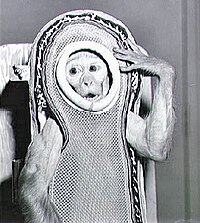
Before humans went into space, several animals were launched into space, including numerous non-human primates, so that scientists could investigate the biological effects of space travel. The United States launched flights containing primate cargo primarily between 1948-1961 with one flight in 1969 and one in 1985. France launched two monkey-carrying flights in 1967. The Soviet Union and Russia launched monkeys between 1983 and 1996. Most primates were anesthetized before lift-off. Overall thirty-two monkeys flew in the space program; none flew more than once. Numerous back-up monkeys also went through the programs but never flew. Monkeys and apes from several species were used, including rhesus monkeys, cynomolgus monkeys, squirrel monkeys, pig-tailed macaques, and chimpanzees.
The first ever primate astronaut was Albert, a rhesus monkey, who on June 11, 1948, rode to over 63 km (39 mi) on a V2 rocket. Albert died of suffocation during the flight.Albert was followed by Albert II who survived the V2 flight but died on impact on June 14, 1949, after a parachute failure. Albert II became the first monkey in space as his flight reached 134 km (83 mi) - past the Kármán line of 100 km taken to designate the beginning of space. Albert III died at 35,000 feet (10.7 km) in an explosion of his V2 on September 16, 1949. Albert IV on the last monkey V2 flight died on impact on December 8 that year after another parachute failure.His flight reached 130.6 km. Alberts I, II, and IV were rhesus monkeys while Albert III was a cynomolgus monkey.

Monkeys later flew on Aerobee rockets. On April 18, 1951, a monkey, possibly called Albert V, died due to parachute failure. Yorick, also called Albert VI, along with 11 mouse crewmates, reached 236,000 ft (72 km) and survived the landing, on September 20, 1951, the first monkey to do so (the dogs Dezik and Tsygan had survived a trip to space in July of that year), although he died 2 hours later. Two of the mice also died after recovery; all of the deaths were thought to be related to stress from overheating in the sealed capsule in the New Mexico sun while awaiting the recovery team.Albert VI's flight surpassed the 50 mile boundary the U.S. used for spaceflight but was below the international definition of space. Patricia and Mike, two cynomolgus monkeys, flew on May 21, 1952, and survived, but their flight was only to 26 kilometers.
On December 13, 1958, Gordo, also called Old Reliable, a squirrel monkey, survived being launched aboard Jupiter AM-13 by the US Army. He was killed due to mechanical failure of the parachute recovery system in the rocket nose cone.
On May 28, 1959, aboard the JUPITER AM-18, Able, a rhesus monkey, and Miss Baker, a squirrel monkey flew a successful mission. Able was born at the Ralph Mitchell Zoo in Independence, Kansas. They travelled in excess of 16,000 km/h, and withstood 38 g (373 m/s2). Able died June 1, 1959, while undergoing surgery to remove an infected medical electrode, from a reaction to the anesthesia. Baker became the first monkey to survive the stresses of spaceflight and the related medical procedures. Baker died November 29, 1984, at the age of 27 and is buried on the grounds of the United States Space & Rocket Center in Huntsville, Alabama. Able was preserved, and is now on display at the Smithsonian Institution's National Air and Space Museum. Their names were taken from a phonetic alphabet.
On December 4, 1959, Sam, a rhesus monkey, flew on the Little Joe 2 in the Mercury program to 53 miles high. Miss Sam, also a rhesus monkey, followed in 1960, on Little Joe 1B although her flight was only to 8 mi (13 km) in a test of emergency procedures. Ham and Enos also flew in the Mercury program but they were chimpanzees. The names 'Sam' and 'Ham' were acronyms. Sam was named in homage to the School of Aerospace Medicine at Brooks Air Force Base in San Antonio, Texas. The name 'Ham' was taken from Holloman Aerospace Medicine at Holloman Air Force Base, New Mexico.
Goliath, a squirrel monkey, died in the explosion of his Atlas rocket on November 10, 1961. A rhesus monkey called Scatback flew a sub-orbital flight on December 20, 1961, but was lost at sea after landing.Bonny, a pig-tailed macaque, flew on Biosatellite 3, a mission which lasted from June 29 to July 8, 1969. This was the first multi-day monkey flight, but came after longer human spaceflights were common. He died within a day of landing.Spacelab 3 on the Space Shuttle flight STS-51-B featured two squirrel monkeys named No. 3165 and No. 384-80. The flight was from April 29 to May 6, 1985.
No comments:
Post a Comment